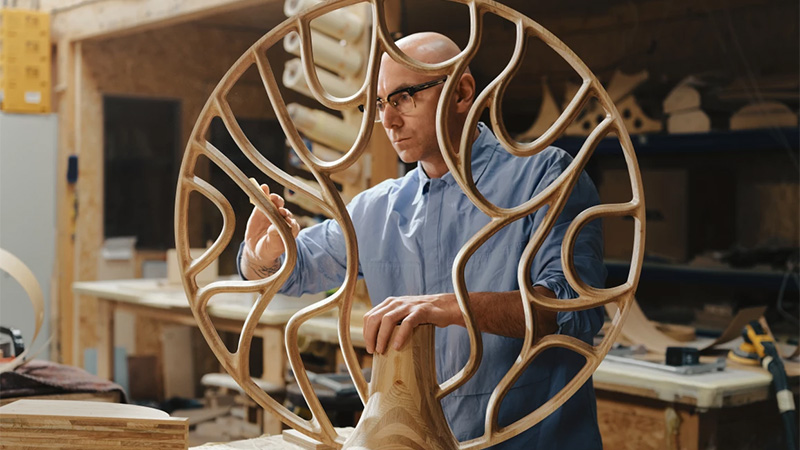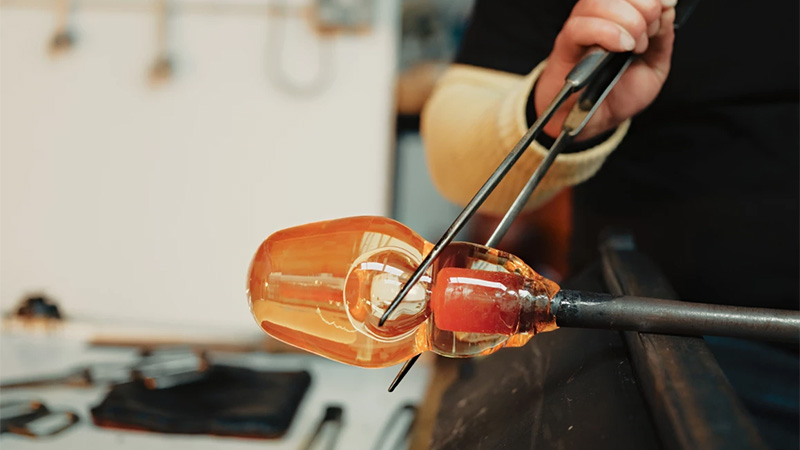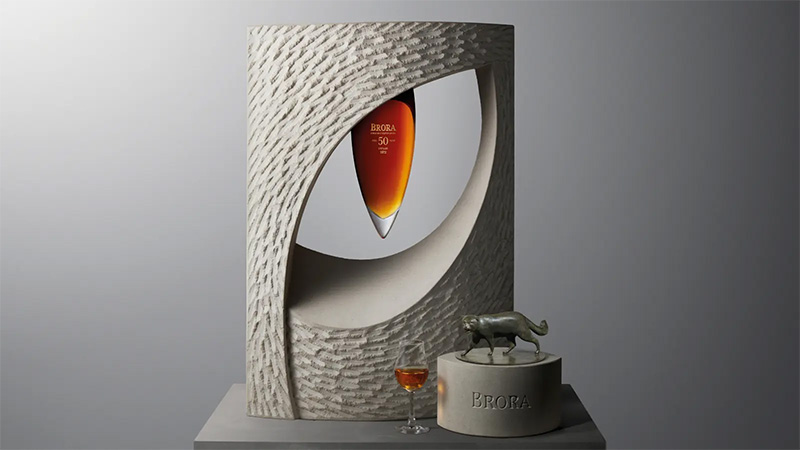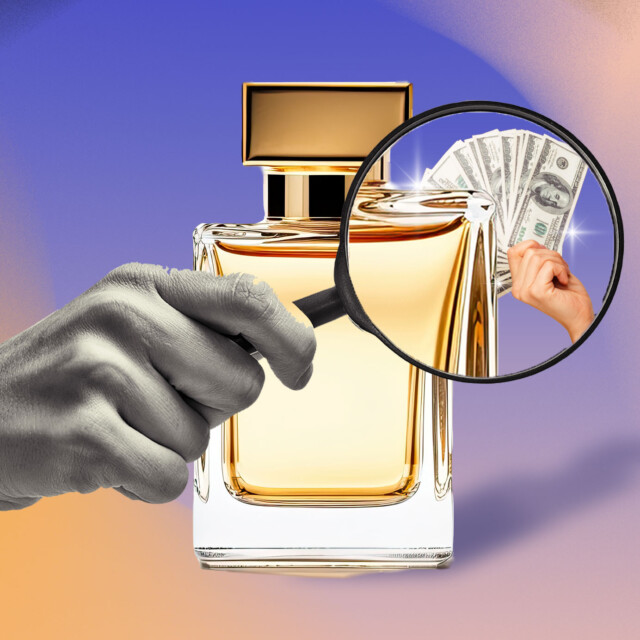Earlier this month the Glen Grant unveiled Devotion, its oldest single malt to date. A sole bottle of the 70-year-old Scotch is currently on auction at Sotheby’s, where it’s expected to retrieve more than $100,000 by the time the hammer drops.
In case there were any doubts, this is a stunning sherry-imbued Scotch, rich and robust, from one of the industry’s most storied distilleries; crafted by one of its most iconic distillers, Dennis Malcolm. And yet when you visit the brand’s dedicated website for the release, description of the liquid itself arrives after that of the decanter and “mesmerizing gem-shaped objet d’art” in which it sits.
This prioritization isn’t a lark. In the world of ultra high-end collectible spirits, bottle design has assumed top billing. And with bottles regularly fetching six figures and up from a global cabal of frenzied collectors, it’s an art form that now doubles as its very own cottage industry.
Meet the Masters
Brodie Nairn has played an outsized role in this evolution. The hot glass master — who blows molten material, slowly shaping and molding it into its final form — co-founded and runs a studio in the Scottish highlands called Glasstorm. Since 2018, he and his team have crafted the ornate — often elaborate — housing for some of the Scotch category’s most memorable one-offs: a striated 50-year-old Glenlivet; a 1957 vintage of Black Bowmore, incorporating Islay surf into its crenulated facade; the Art Deco rendering of an impossibly rare Macallan juice, bottled specifically to commemorate the 125th anniversary of The Savoy in London. These are but a few recent standouts from his impressive portfolio.
None of these pieces are conceived in a vacuum. Conceptually, they are intended as extensions of the liquids within. “We want to make sure that the design is original and relevant to the story being told,” Nairn tells VinePair. “We believe that without an honest story there is no meaning behind a project and it can become just a fancy bottle that has nothing to do with the whisky or the distillery.”
This outcome is typically avoided by way of prolonged dialogue between Nairn and the folks who craft the actual liquid. He describes the process playing out for as long as two years for a particularly fussy client (whom he preferred not to name). In the case of the Glen Grant Devotion, though, conversations with Malcolm provided almost immediate inspiration. The master distiller imagined a singular theme: a 70-year-old whisky dedicated — or devoted, if you prefer — to Queen Elizabeth II and her 70-year reign.

And so Nairn set out to evoke Her Majesty, in the form of a pointed vessel with proportional style and grace. The jewel-shaped decanter is enclosed in a silver crown. The metallic topper flows seamlessly into the crystal below and is engraved with depictions of lily of the valley, the Queen’s favorite flower. It rests at the center of a circular wooden sculpture, which Nairn’s frequent collaborator John Galvin — who specializes in designing the sculptures encasing the glass — shaped from a fallen elm tree recovered from the distillery gardens.
“To make one from start to finish takes roughly 250 hours of highly skilled craftsmanship,” says Galvin of its execution.
As it is, the packaging takes on a decidedly native motif, even if its designers never personally sampled the whisky at its core. “I find a little taste can help get the creative juices going but it is not essential,” Nairn says.
“It makes no sense to me that if you buy a bottle of an ultra-rare whisky for 2 million USD, the only thing you get is a bottle similar to all other bottles, and a mere standard wooden box.”
In fact, there’s a good chance that the purchasers of bottles priced higher than an entry-level Porsche aren’t ever going to taste these opulent liquids either.
“Unfortunately, the super-high-end releases are not aimed at whisky lovers, but people with extremely high disposable incomes,” says Iain McPherson, whisky expert and owner of some of Scotland’s top-rated cocktail bars. “So the liquid needs an added perceived value. It is what it is.”
A Million Dollar Case Race
Distillers, for their part, can’t rewrite the laws of supply-and-demand economics. Half-century-old whisky is exceedingly rare and as coveted as it has ever been. It’s going to command jaw-dropping pricing as a result. And so they might as well lean into this inevitability with a near-farcical degree of ostentatiousness. But according to world-renowned craftsman Tiago Russo, luxury design isn’t about embellishing things to make them look more expensive.
“That’s actually anti-design,” says the man who helped birth the bottles in Macallan’s Reflexion series. “It’s about creating a truly unique, meaningful, immersive and intimate connection with the user. It makes no sense to me that if you buy a bottle of an ultra-rare whisky for 2 million USD, the only thing you get is a bottle similar to all other bottles, and a mere standard wooden box. That product has to speak to you, to embed in all your senses, to make it an emotional relation.”

As chief design officer for the Craft Irish Whiskey Company, Russo is encouraged to shift this sort of product immersion into overdrive. This is the man responsible for rendering the Emerald Isle Collection — a 30-year-old Irish single malt housed proudly alongside a Celtic Fabergé egg, a Cuban cigar, and a timepiece. Last year, his work on the project netted him Platinum recognition at the prestigious A’Design Awards. The set recently sold for just under $3 million to an American collector.
Indeed, it feels as though a space race is on for next-level design, with each subsequent release aiming to raise the stakes. An opulent decanter is now merely one component of the final product. Earlier in the month Brora, a distillery revived in 2021 after becoming a cult favorite among Scotch collectors during its dormancy and now a cult favorite among Scotch collectors the world over, released its oldest expression, Iris. The 50-year-old, burgundy-hued Scotch rests within the aperture of a limestone sculpture. From a distance, the liquid appears as the infernal eye of a mythical beast.

“We represented the sheer age of this rare and valuable whisky with the rugged surface of the material,” explains Michelle De Bruin, the Scottish sculptor behind Brora Iris. “The whisky bottle is then suspended within the sculpture as if it’s suspended in time.”
The bottle — which is unlocked by a separate bronze “key” shaped like a wildcat — went to auction just last week. A current bid of £85,000 (roughly $105,000) already distinguishes it as the highest-priced release ever to come from the storied distillery.
Last year, a one-of-one edition of 81-year-old Scotch from The Macallan recorded a hammer price of £240,000 (roughly $297,000) at auction. The mouth-blown decanter is cradled by three bronze hands that scan as misplaced setpieces from the movie “Labyrinth.”
“If you spend $3 million on a car, you expect that experience to be outrageously different than if you buy a $30,000 one,” Russo reasons. “So why wouldn’t that be applied to a great whisky?”
It’s a valid point. So long as the quality of the liquid remains the driver of said experience, and not confined to the back seat.
This story is a part of VP Pro, our free platform and newsletter for drinks industry professionals, covering wine, beer, liquor, and beyond. Sign up for VP Pro now!
